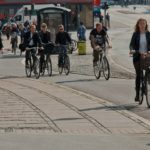Posts in the 'Integrated Transport' category
Chennai, India has long been notorious for its lawless auto-rickshaw drivers. On August 25, 2013, the Tamil Nadu state government sought to change this perception by reforming rickshaw fare structures for the first time in 17 years. The government was ...

Lagos – the largest city and commercial capital of Nigeria – has traditionally struggled with a lack of reliable mass transit systems and severe traffic congestion. The average Lagos commuter spends over three hours in traffic every day. More recently, ...

Increased bus fares are a greater concern to Brazilian citizens than increased electricity, water or telephone bills. This fact and others come from a recent study presented at the Brazilian National Association of Transport Operators (NTU) 2014 National Seminar on ...

Claudia Adriazola, Health and Road Safety Director for EMBARQ – producer of TheCityFix – spoke with David Thorpe of the Sustainable Cities Collective about challenges, trends and best practices in sustainable transport and road safety. Among other topics, Adriazola and ...

Conducted by the Brazilian National Association of Transport Operators (NTU), this year’s Seminar on Urban Public Transportation responded to a growing demand among Brazilian citizens for improved public transport. On August 27 and 28, 2014, city planners, experts, transport operators, ...

Ljubljana, Slovenia has won the 2016 European Green Capital Award, given annually by the European Commission to cities that set an example of sustainable urban development best practices. With an ambitious sustainability plan and that has led to significant improvements in the ...

In 2004, Medellín – the second largest city in Colombia – introduced the Medellín Metrocable system to connect low-income residents to public transport. As the world’s first modern urban aerial cable car transport system, this innovative addition to Medellín’s existing ...

The city of São Paulo has won the 2014 Enterprising City/State MobiPrize following its support of user information and public participation platforms to advance sustainable transport solutions. MobiPrize was launched in 2012 by the University of Michigan SMART (Sustainable Mobility ...

Instead of sitting in gridlock on a busy road at 8:30 am, imagine cycling safely in dedicated lanes for a quick, pleasant commute. Many cities around the world are making investments that will give residents a faster, safer cycling experience ...

China’s increasing overall wealth makes it unlikely that the country’s growth in car ownership will stop any time soon. However, severe air pollution and traffic congestion have led several large Chinese cities to take action to stem the rising tide ...

Congestion, high levels of air pollution, and traffic crashes are consequences of a culture of investment that has focused for decades on the automobile. These externalities can cost up to 10 percent of a country’s GDP, and the world’s vehicle fleet is ...

Sustainable urban mobility can come from multiple sources. Personal rapid transit (PRT) combines public transport with personalized routing. Though their designs vary, PRT systems generally consist of four- to six-passenger pods that are autonomously controlled while traveling along guide-ways. Instead ...

The “People-oriented Cities” series – exclusive to TheCityFix and Insights – explores how cities can become more sustainable and livable through transit-oriented development (TOD). The nine-part series addresses different urban design techniques and trends that reorient cities around people rather ...

The Economist recently argued that streetcars are “a waste of money,” citing their high capital costs and inefficiencies as a means of transport. Others have argued that streetcars can be a catalyst for creating dynamic, vibrant urban environments. Both arguments ...

Sustainable mobility is a key challenge for city leaders. Mexico City – the world’s fourth most populous city, with more than 20 million inhabitants in its metropolitan area – is no different. The city must overcome a long history of urban ...

Page 26 of 135« First...1020...252627...3040...Last »
























